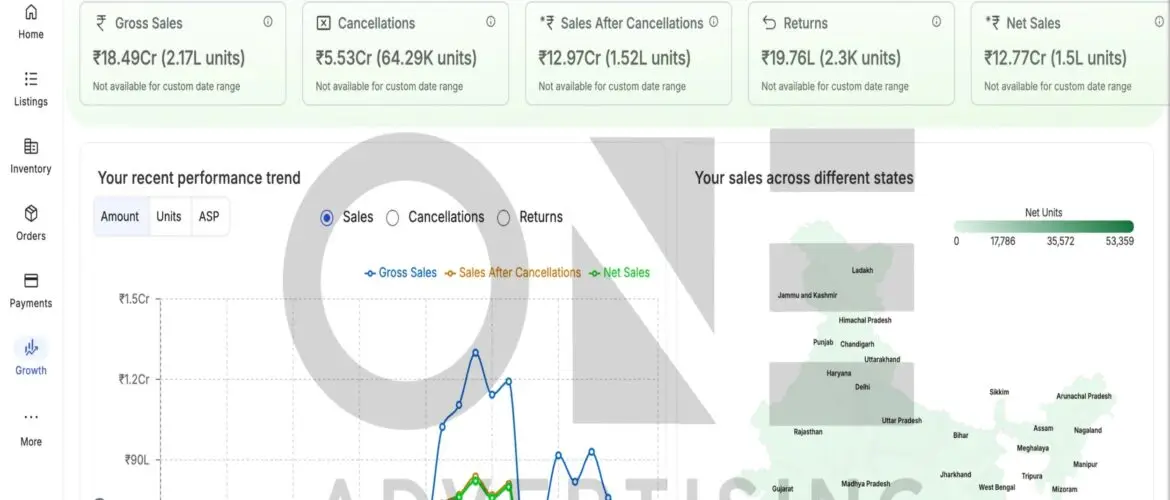There are several difficulties in the way of scaling Direct-to-Consumer (D2C) companies in their quickly changing environment. A planned, data-driven approach for marketing is necessary for building a brand that is capable of handling impressive expansion, given the intense competition and extremely narrow margins.
In just six months, a relatively unknown FMCG (fast-moving consumer goods) direct-to-consumer business gained incredible results. Beginning with a small initial expenditure of ₹4 crore, the brand used a well-planned performance marketing approach to convert that investment into almost ₹45 crore in gross sales across a number of channels.
We will guide you through the difficulties faced, the strategic approach we took, the techniques One Advertising used, and the outstanding outcomes we were able to achieve in this comprehensive case study. This case study provides insights into how a well-managed media engine can enable exponential development, even in highly competitive markets, for anyone working in the industry, be it a founder, marketer, or agency expert.
The Market Context: Challenges Faced by the Brand
One of India’s busiest and cutthroat markets is the FMCG sector. With so many options available to consumers, companies often find it difficult to stand out from the competition. Among the difficulties this specific D2C brand encountered were:
- High Level of Competition: Many well-established companies and up-and-coming startups are fighting for customer’s attention. Because of the limited margins, every rupee spent on advertising was important.
- Restricted Awareness of the Brand: Due to its recent arrival, the brand was not well-known to the target market. Customers interacted with the brand’s website as well as marketplaces like Flipkart and Amazon, creating a fragmented customer journey.
- Need to Scale Quickly: To gain market share before competition did, the founders were keen to expand quickly.
Despite these hurdles, the brand was clear about one thing: they wanted to grow fast and were willing to invest accordingly.
The Approach: Building a Robust Media Engine
Creating a detailed, scalable media plan that could produce dependable, measurable results was our objective.
The following basic foundations were our main focus:
1.Multi-Platform Approach
Rather than depending exclusively on one channel, we developed a multifaceted media strategy that included:
- Meta (Facebook & Instagram): To scale effectively, retarget interested users, and reach large audiences.
- Marketplaces (Amazon & Flipkart): To increase ROAS, manage AOV, and take advantage of high-intent purchasing traffic.
- Own Website: To control margins, optimize for repeat business, and establish a direct interaction with clients.
From awareness to conversion, our multi-platform strategy made sure the brand was visible at every point in the funnel.
2.Performance-Driven Campaigns
To expand volume and keep profitability, we took a Meta Ads-first approach.
This included:
- Ad creatives are optimized for conversion and engagement.
- On the basis of detailed client personas, highly targeted campaigns are created.
- Implementing innovative bidding techniques to minimize expenses and optimize profits.
3.Synergy B/w Marketplace and Website
Although high-intent traffic came from marketplaces like Flipkart and Amazon, the website acted as a platform to:
- Provide special product packages.
- To raise AOV, upsell, and cross-sell.
- Gather client information for remarketing.
We were able to optimize lifetime value and manage the customer experience by striking a balance between various channels.
4.Innovative Testing and Optimization
We created more than 300 creatives and tested various formats, images, and messaging regularly.
Through this iterative method, we were able to:
- Determine which creatives were successful and connected with the audience.
- Cut down on ad fatigue.
- Enhance the campaign’s overall effectiveness.
5.Budget and Bid Management in Real Time
We maximized every rupee spent by using effective budget restrictions and real-time bid revisions. We were able to reduce losses on unsuccessful efforts and profit from high-performing ones thanks to this flexible strategy.
6.Continuous Testing & Micro-Campaigns
We conducted hundreds of micro-ads divided by target, product, and creative in place of big, monolithic campaigns.
This attention to detail enabled us to:
- Accurately monitor performance.
- Rapidly test new creatives.
- Make data-driven strategy changes.
Implementation Details
In close collaboration with the internal marketing team of the brand, our group established a systematic procedure for creating, tracking, and refining campaigns:
- Audience Segmentation: According to buying intent, interests, and demographics.
- Creative Development: A combination of offers, lifestyle photos, product demonstrations, and testimonials. The campaigns were organized into three stages: awareness, contemplation, and conversion.
- Tracking Metrics: Pixel tracking and UTM parameters were implemented for comprehensive attribution in the data tracking process.
- Weekly Optimization: Consistent review sessions to examine data, spot patterns, and adjust campaigns.
- Scaling: To guarantee long-term growth, gradually raise ad spending on successful campaigns.
Results: Quantifiable Success
Over six months, our performance marketing efforts yielded unprecedented results for the brand:
Metric | Result |
₹18 Crore | Revenue from Flipkart alone |
₹45+ Crore | Total gross sales across Flipkart, Amazon, and the website |
Zero ATL Spend | All growth is driven through performance marketing channels |
Repeat Purchase Rate | Increased by 2.6 times, indicating higher customer loyalty |
Margins & ROAS | Maintained healthy margins despite aggressive scaling |
Customer Acquisition Cost (CAC) | Significantly reduced through optimized creatives and bidding |




Leave A Comment